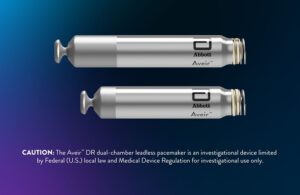
Abbott (NYSE:ABT) today announced late-breaking results from a study of its Aveir dual-chamber (DR) i2i leadless pacemaker.
Data came from the company’s large-scale FDA investigational device exemption (IDE) study. It assesses Aveir DR, the world’s first dual-chamber leadless pacemaker for safety and performance. Abbott said the data suggests that Aveir DR could offer new benefits for those with slower-than-normal heart rhythms.
The company presented results at Heart Rhythm Society’s 44th annual meetings in New Orleans. The New England Journal of Medicine simultaneously published the data. Abbott also provided this data to the FDA as part of its submission for approval of Aveir DR.
Aveir DR delivers electrical impulses directly to the heart muscle via thin, insulated wires, known as cardiac leads. This restores the normal heart rhythm. Unlike traditional pacemakers, the leadless devices go directly into the heart through a minimally invasive, catheter-based procedure. This eliminates the need for cardiac leads and a pulse generator under the skin.
Abbott said that, while many people require pacing and sensing in both the right atrium and right ventricle, currently available leadless pacing options have been limited to single-chamber ventricular devices. The company attributed this to the technological challenge of wireless synchronization for two leadless pacemakers.
Principal investigator Dr. Reinoud Knops said dual-chamber, leadless pacemakers have never been an option due to those challenges. Knops serves as a professor of medicine at Amsterdam University Medical Center, the Netherlands.
“Data from the AVEIR DR i2i study show that Abbott has designed a groundbreaking technology for seamless communication between two leadless pacemakers, and that AVEIR DR can deliver appropriate therapy safely, opening up a future treatment option for more people with abnormal heart rhythms,” Knops said.
About Aveir DR and the Abbott study
Abbott designed Aveir DR with a first-of-its-kind implant-to-implant (i2i) technology. It provides beat-to-beat communication and synchrony between the two leadless pacemakers. Unlike other leadless options, the system enables the two devices to communicate with one another. They can sense for delayed or missed heartbeats and pace the appropriate chamber of the heart.
The Aveir devices utilize specially designed attachment mechanisms that allow for the retrieval of pacemakers when necessary, too. In the study, physicians successfully implanted leadless pacemakers in the right atrium along with a leadless device in the right ventricle for the first time.
Abbott’s study analyzed primary safety and efficacy endpoints in the first 300 people enrolled. The study evaluated participants across 55 centers in the U.S., Canada and Europe through three months post-implant.
Results demonstrated a 98.3% implant success rate. The study achieved its safety endpoint evaluating freedom from device or procedure-related complications, too.
Abbott said more than 97% of people presented successful atrioventricular (AV) synchrony. This means the upper and lower chambers beat normally, despite different types of underlying slow heart rhythms. The average AV synchrony came in at 95% in each of seven different posture and walking speeds. Abbott said this demonstrated that the system functions appropriately during everyday life activities.
“For the first time, the AVEIR DR i2i study has shown that a dual-chamber leadless pacing device is not only possible but can meet the rigors of everyday needs of pacing therapy,” said Randel Woodgrift, SVP of Abbott’s cardiac rhythm management business. “The results of the AVEIR DR study are a strong indicator that the AVEIR dual-chamber pacemakers can offer new options so that physicians can treat a broader group of people that need pacemaker therapies. ”